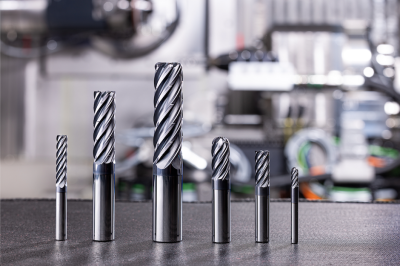
CERATIZIT added to its OptiLine Series of solid-carbide end mills with the launch of a six-flute end mill. OptiLine end mills are versatile and optimized for various materials, machining strategies and part applications. The company designed and developed the new six-flute OptiLine end mill specifically for titanium and super alloys (ISO-S).
Engineered from the ground up, the OptiLine six-flute end mill features a premium substrate and advanced tool geometry. The end mill’s asymmetrical variable helix and variable index flute configuration ensures enhanced stability during cutting operations and includes chip splitters designed for applications involving 2.5 x D cutting lengths. Refined cutting edges and CERATIZIT’s Dragonskin coating technology improve chip control and reduce adhesion for longer tool life.
“We started with the six-flute’s foundation ensuring the substrate provides high toughness without sacrificing hardness,” says Scott Walrath, CERATIZIT Business Development Manager, Solid Round Tools. “The six-flute’s other key differentiator is the asymmetrical flute design because each tooth on a different helix angle delivers stability when machining a workpiece at varying angles.”
To accommodate customers across U.S. industry sectors, the new six-flute end mill will be available in inch assortments. OptiLine inch-type end mills, including the new six-flute, are manufactured at CERATIZIT’s facility in Sacramento, California.
CERATIZIT will feature the new OptiLine six-flute at IMTS in booth #431900 in the West Building. It will also be included in the company’s dual dimension tool catalog specifically for North American markets that will be released in August and available at IMTS 2024.
Contact Details
Related Glossary Terms
- alloys
alloys
Substances having metallic properties and being composed of two or more chemical elements of which at least one is a metal.
- hardness
hardness
Hardness is a measure of the resistance of a material to surface indentation or abrasion. There is no absolute scale for hardness. In order to express hardness quantitatively, each type of test has its own scale, which defines hardness. Indentation hardness obtained through static methods is measured by Brinell, Rockwell, Vickers and Knoop tests. Hardness without indentation is measured by a dynamic method, known as the Scleroscope test.
- helix angle
helix angle
Angle that the tool’s leading edge makes with the plane of its centerline.
- milling machine ( mill)
milling machine ( mill)
Runs endmills and arbor-mounted milling cutters. Features include a head with a spindle that drives the cutters; a column, knee and table that provide motion in the three Cartesian axes; and a base that supports the components and houses the cutting-fluid pump and reservoir. The work is mounted on the table and fed into the rotating cutter or endmill to accomplish the milling steps; vertical milling machines also feed endmills into the work by means of a spindle-mounted quill. Models range from small manual machines to big bed-type and duplex mills. All take one of three basic forms: vertical, horizontal or convertible horizontal/vertical. Vertical machines may be knee-type (the table is mounted on a knee that can be elevated) or bed-type (the table is securely supported and only moves horizontally). In general, horizontal machines are bigger and more powerful, while vertical machines are lighter but more versatile and easier to set up and operate.







